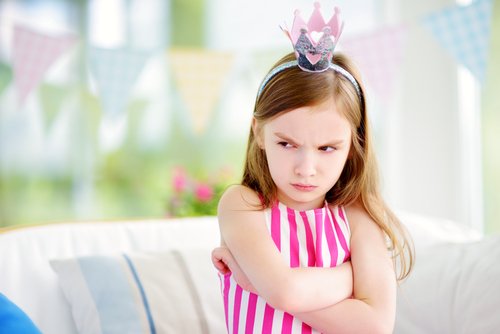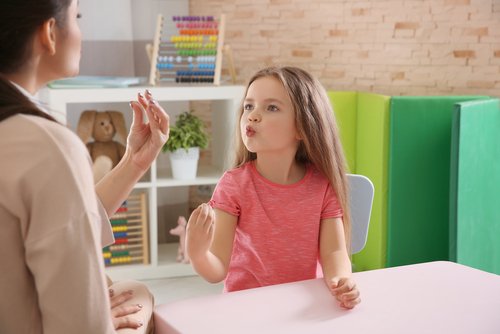The Stoplight Technique for Helping Children Manage Anger

When the emotional volcano erupts, we often see parents react erroneously, in two different ways. Some parents adopt an even more irrational posture. Others are more indulgent and let their children manipulate them. Clearly, neither of these reactions is correct.

Red, yellow and green: Each light has a meaning
This self-management method consists of showing our children a graphic representation of their emotional state. Each time there is a problem, we explain what phase they are in and what this involves.
Let’s look at what each color of the stoplight means:
- Red: Your child is overcome by anger and, if he doesn’t change his attitude, there will be consequences. If your child doesn’t stop, the consequences should be applied. This is the moment when we show the child the color red.
“What if there were a mechanism to help our children manage their own outbursts? Good news! That’s exactly what the stoplight technique is all about.”
- Yellow: It’s time to think. Your child is agitated, but still hasn’t lost control. This is a state of alert where we can still invite our children to reason.
- Green: The child dialogues, speaks and receives explanations regarding what he wants. If your child continues with this state of calm, we show him the color green and congratulate him for his self-control. During this phase, we can offer our child solutions to the problem and even provide positive reinforcement.
How do I get started?
One day, when you notice your child is getting upset, explain the stoplight technique. You can tell your child you’re tired of punishing her and that’s why you’re going to put this new procedure or agreement in place.
Then, place a stoplight made of poster board or construction paper on the wall.
You can cut out red, yellow and green circles and place them on the stoplight one at a time according to your child’s current emotional state.
You can also stick them all on at once and point to whichever represents your child’s state at any given time.
It’s good to use this method when you’re out of the house as well. Depending on your child’s emotional state, you tell her what color of the stoplight she’s at.
Some considerations about the stoplight technique
We can use this method with children up to age 5. The idea isn’t to control the child through punishment, but rather orient the child so that he can manage his own stages of anger.
Your child will have sufficient time and warnings before things get out of control.

The objective of this technique is simple: Children should learn over time to identify their level of impulsiveness.
The colors will serve as an illustration to help them think before continuing. In some ways, this is similar to counting to ten before losing control.
Of course, this method requires time and commitment on behalf of parents. You may even want to take advantage of more relaxed moments and play times to have your child identify impulsivity levels with colors.
The technique is similar to when we teach our children colors and numbers.
“The objective of this technique is simple: Children should learn over time to identify their level of impulsiveness.”
Advantages of this self-control technique
- The teachings related to emotional intelligence are more didactic and practical. Without a doubt, this is much more effective than becoming aggressive or becoming as upset as our children. When we lose control as adults, we send unclear messages to our children.
- With the implementation of this technique, we give our children the chance to become aware of their own character; it is a learning opportunity. The activity will also help your child to make changes in her own behavior.
- The rules will be very clear and the child will internalize the ability to self-manage her emotional state. Of course, in order for this technique to be effective, parents must serve as examples and be patient enough to explain it. The goal is that our children become adults who can reason and be self-disciplined.
When the emotional volcano erupts, we often see parents react erroneously, in two different ways. Some parents adopt an even more irrational posture. Others are more indulgent and let their children manipulate them. Clearly, neither of these reactions is correct.

Red, yellow and green: Each light has a meaning
This self-management method consists of showing our children a graphic representation of their emotional state. Each time there is a problem, we explain what phase they are in and what this involves.
Let’s look at what each color of the stoplight means:
- Red: Your child is overcome by anger and, if he doesn’t change his attitude, there will be consequences. If your child doesn’t stop, the consequences should be applied. This is the moment when we show the child the color red.
“What if there were a mechanism to help our children manage their own outbursts? Good news! That’s exactly what the stoplight technique is all about.”
- Yellow: It’s time to think. Your child is agitated, but still hasn’t lost control. This is a state of alert where we can still invite our children to reason.
- Green: The child dialogues, speaks and receives explanations regarding what he wants. If your child continues with this state of calm, we show him the color green and congratulate him for his self-control. During this phase, we can offer our child solutions to the problem and even provide positive reinforcement.
How do I get started?
One day, when you notice your child is getting upset, explain the stoplight technique. You can tell your child you’re tired of punishing her and that’s why you’re going to put this new procedure or agreement in place.
Then, place a stoplight made of poster board or construction paper on the wall.
You can cut out red, yellow and green circles and place them on the stoplight one at a time according to your child’s current emotional state.
You can also stick them all on at once and point to whichever represents your child’s state at any given time.
It’s good to use this method when you’re out of the house as well. Depending on your child’s emotional state, you tell her what color of the stoplight she’s at.
Some considerations about the stoplight technique
We can use this method with children up to age 5. The idea isn’t to control the child through punishment, but rather orient the child so that he can manage his own stages of anger.
Your child will have sufficient time and warnings before things get out of control.

The objective of this technique is simple: Children should learn over time to identify their level of impulsiveness.
The colors will serve as an illustration to help them think before continuing. In some ways, this is similar to counting to ten before losing control.
Of course, this method requires time and commitment on behalf of parents. You may even want to take advantage of more relaxed moments and play times to have your child identify impulsivity levels with colors.
The technique is similar to when we teach our children colors and numbers.
“The objective of this technique is simple: Children should learn over time to identify their level of impulsiveness.”
Advantages of this self-control technique
- The teachings related to emotional intelligence are more didactic and practical. Without a doubt, this is much more effective than becoming aggressive or becoming as upset as our children. When we lose control as adults, we send unclear messages to our children.
- With the implementation of this technique, we give our children the chance to become aware of their own character; it is a learning opportunity. The activity will also help your child to make changes in her own behavior.
- The rules will be very clear and the child will internalize the ability to self-manage her emotional state. Of course, in order for this technique to be effective, parents must serve as examples and be patient enough to explain it. The goal is that our children become adults who can reason and be self-disciplined.
All cited sources were thoroughly reviewed by our team to ensure their quality, reliability, currency, and validity. The bibliography of this article was considered reliable and of academic or scientific accuracy.
- Bisquerra, R. (2011). Educación emocional. Propuestas para educadores y familias. Bilbao: Desclée de Brower. http://otrasvoceseneducacion.org/wp-content/uploads/2019/04/Educación-Emocional.-Propuestas-para-educadores-y-familias-Rafael-Bisquerra-Alzina-2.pdf
- Goleman, D. (2010). La práctica de la inteligencia emocional. Editorial Kairós.
- López, M. (2008). La integración de las habilidades sociales en la escuela como estrategia para la salud emocional. Psicología sin fronteras: revista electrónica de intervención psicosocial y psicología comunitaria, 3(1), 16-19.
- Shapiro, L. E. (2002). La salud emocional de los niños (Vol. 16). Edaf.
This text is provided for informational purposes only and does not replace consultation with a professional. If in doubt, consult your specialist.








